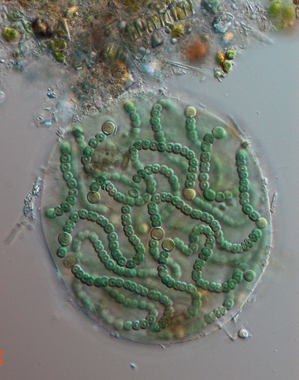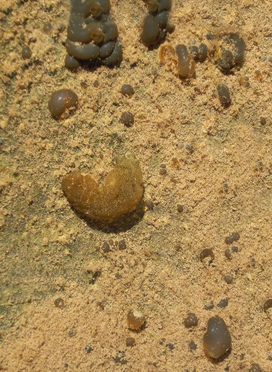
© CDC/ JANICE HANEY CARR/JEFF HAGEMAN, M.H.S.
29 |
Text by Sanet Janse van Vuuren |
|---|---|
Prokaryotes are primitive cells lacking both a membrane enclosing the nucleus, and organelles such as chloroplasts and mitochondria. Prokaryotic organisms fall into two domains, the Archaea and the Bacteria. The Archaea, ancient bacteria-like life forms that live in extreme environments, are not dealt with here. The Bacteria include the photosynthesising Cyanobacteria (= Cyanophyta) and various groups of heterotrophs, only a few of which cause diseases in humans. Some bacteria have external whip-like flagella used in locomotion, while others perform gliding movements through mucous secretions. Some prokaryotes are unicellular while others form clumped or filamentous colonies. Measurements are given in micrometres (μm).

© CDC/ JANICE HANEY CARR/JEFF HAGEMAN, M.H.S.

© CDC /JANICE HANEY CARR

© W. ALAS-SNIG (WIKIMEDIA COMMONS PUBLIC DOMAIN)

© J. GATHAN/YCDC
Bacteria were among the first life forms to appear on earth and are present virtually everywhere. They are only a few micrometres in length, and almost a million bacterial cells can be found in a single millilitre of fresh water. Nevertheless the total biomass of bacteria exceeds that of all plants and animals combined. Bacteria can move using flagella, glide, or perform a twitching motility. Bacteria are all single-celled and although there are thousands of species, all are basically one of four different shapes: round (cocci, 1), rod-shaped (bacilli, 1a), spiral-shaped (spirilla, 1b) or comma-shaped (vibrio, 1c). Although many bacteria are beneficial and play a vital role in nutrient recycling, others can be pathogenic and cause infectious diseases. Bacteria are important in sewage treatment, breakdown of oil spills, production of cheese and yoghurt, recovery of metals in the mining sector, and in biotechnology.
Usually blue-green in colour, and can be single cells, colonies, branched or unbranched filaments. Some are non-motile, while others glide by mucous excretions. Exhibit only asexual reproduction by cell division, fragmentation or budding. Gas vacuoles provide buoyancy in some genera. Proliferate under nutrient-rich conditions, causing problems such as scums, unpleasant tastes, odours, skin irritations and release of toxic substances. When they decay, severe oxygen depletion may occur, resulting in fish kills. The phylum contains about 150 genera and 2,000 species.
2 Microcystis
Microcystis species


© S. JANSE VAN VUUREN

© S. JANSE VAN VUUREN

© A. S. VAN STRATEN
Cells arranged in colonies that are initially spherical, but become irregular or perforated over time. Cells may be grouped tightly or sparsely within the fine, colourless, colonial mucilage. Each colony consists of thousands of very small spherical to subspherical cells. Species are differentiated by cell size, presence of gas vacuoles, nature of mucus and shape of colony. Size: Cells 0.5–9µm in diameter. Biology: Prefer high water temperatures and usually form blooms (2a) during summer in water bodies with excess phosphorus and nitrogen. Dense growths, like those experienced in the Hartbeespoort Dam (2b) in North West province, may lead to death of fish by suffocation, as a result of oxygen depletion. Toxins may poison animals ingesting the contaminated water and have been implicated in human illnesses, such as necrosis of the liver (from ingestion) and severe dermatitis (from skin contact). Blooms of Microcystis can impart taste and odour to the water and interfere with recreational activities.
3 Merismopedia
Merismopedia species


© A. VENTER
Colonies consist of small rounded or oval cells, which divide in only two directions to produce flat, rectangular, plate-like colonies. Cells, in multiples of four, arranged in a single layer in perpendicular rows within colourless mucilage. Species differentiated by cell size, presence or absence of vacuoles, and by size of colony. Size: Cells 1–10µm in diameter. Biology: Colonies free-floating or resting on the bottom sediments, where they may form thin films.
1 Anabaena
Anabaena species


© A. VENTER

© K. BRUUN

© S. JANSE VAN VUUREN
Anabaena species form unbranched filaments (called trichomes) without mucous sheaths that can be straight, curved, or coiled. These filaments consist of spherical, ellipsoidal or cylindrical cells, often resembling strings of beads. They lack a distinct sheath, but some species are enveloped in soft colourless mucilage. Certain specialised cells fix nitrogen and others are able to survive under adverse conditions. Gas vacuoles provide buoyancy. Size: Cells 7–12µm in diameter. Biology: Common, widespread and abundant in summer. Certain species live as symbionts in the Red water fern (Azolla filiculoides) (p.312, 5). When nutrients are abundant, some species form blooms, visible as surface scums, imparting odours and tastes to the water. Anabaena can produce toxins, and animals may die after drinking contaminated water. Blooms can also cause severe dermatitis. RELATED GENERA: In Nostoc (1a), twisted trichomes are enveloped within a very firm gelatinous yellow, brown or black matrix. Often forms jelly-like balls (1b) visible with the naked eye.
2 Arthrospira
Arthrospira species


© S. JANSE VAN VUUREN

© B. HOHLS

© S. JANSE VAN VUUREN

© M. GRIFFITHS
Trichomes (filaments) unbranched, usually in the form of large, regular, screw-like coils, resulting in a spiral. They may be solitary or form thin mats. Multicellular, but at times cross walls are difficult to see. Usually non-motile, but occasionally glide while rotating. Most species have gas vacuoles. Species differ mostly by size and by form of the spiral (closely coiled or loose). Size: Trichomes 8–10µm in diameter and 100–200µm in length. Biology: Common in pools and lakes, having the ability to proliferate in very mineralised, alkaline and warm waters, where few living organisms can survive (2a). RELATED GENERA: Spirulina (2b) is a genus very similar to Arthrospira and certain species have been moved from one genus to the other. Some researchers think Arthrospira should be included within Spirulina, but genetic and morphological analyses confirm that the genera are distinct. Arthrospira is an edible cyanobacterium that is mass cultivated (2c) and sold commercially under its old name, Spirulina. No cyanobacteria actually belonging to Spirulina have been tested as sources of nutrition, nor does a market exist for them. Arthrospira and Spirulina have similar shapes, but the former is separated by some authors as having obvious cross walls. Arthrospira has broad filaments that are less tightly coiled than those of Spirulina. In Spirulina the spirals (typically 200–300µm) are often tightly coiled, with a diameter of 5–6µm.
3 Oscillatoria
Oscillatoria species


© K. BRUUN

© K. BRUUN
Cylindrical unbranched trichomes (filaments), usually straight, often very long. Individual cells discoid and shorter than broad. Trichomes may taper slightly, often with rounded end cells, with or without caps. No mucilaginous sheath; may leave thin mucilaginous trail as they glide, as mucilage is secreted through pores in cell walls. Genus name derived from the gliding, rotating, or oscillating motion of the filament around its axis when in contact with a solid substratum. Gas vacuoles common in planktonic forms. Species separated on basis of size and morphology of apical region. Size: Trichome usually 8–30µm in diameter. Trichome length varies greatly with species. Biology: Widespread in a range of habitats. Can be free-floating or entwined with attached filamentous algae. Some species highly tolerant of organic pollution and often found together with Euglena (p.322, 1) in waters with high nitrogen levels. Some species produce toxins. RELATED GENERA: Difficult to distinguish Oscillatoria, Phormidium and Lyngbya from one another, even for specialists. Lyngbya (3a) species are enclosed in a firm sheath.
4 Chroococcus
Chroococcus species


© S. JANSE VAN VUUREN
Colonies usually composed of two, four, or eight cells inside a mucilaginous envelope. Cells usually hemispherical, since daughter cells do not fully separate after division. Colonies can form macroscopic gelatinous mats. Size: Cells 0.4–40µm in diameter. Biology: Widely distributed in fresh water, as plankton, around aquatic plants, in lake sludge or on riverbeds.
5 Glow caps
Gloeocapsa species


© S. JANSE VAN VUUREN
Gloeocapsa may be unicellular, or made up of groups of round, oval or ellipsoidal blue-green or olive-green cells embedded in dense mucilage formed by concentric layers of sheath, each layer corresponding to a round of division. The sheaths are colourless or vivid shades of yellow, brown, red, orange, blue, or violet; colour may be affected by changes in pH. Colonies are usually microscopic and spherical. Size: Cells 2–18µm in diameter and colonies as large as 60µm in diameter. Biology: Mostly on wet rocks or plants and, less often, on moist soil, other terrestrial surfaces or in freshwater plankton. G. magma grows on roofs, forming black stains and streaks that are difficult to remove. Gloeocapsa also forms the photosynthesising component of the lichen Pyrenocollema. RELATED GENERA: Chroococcus (see 4, above) is similar, but colonies of Gloeocapsa usually contain more cells and noticeable concentric layers in the sheath.